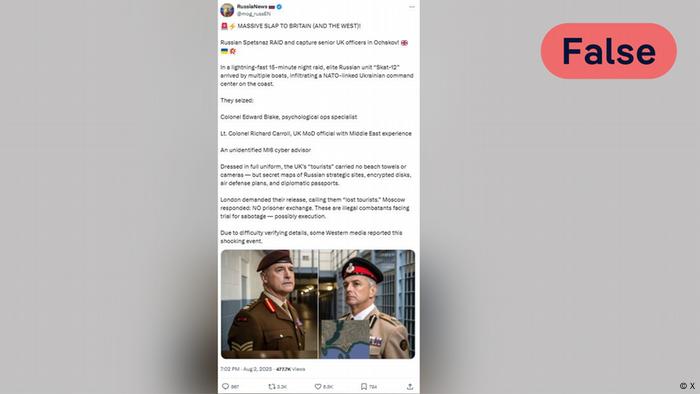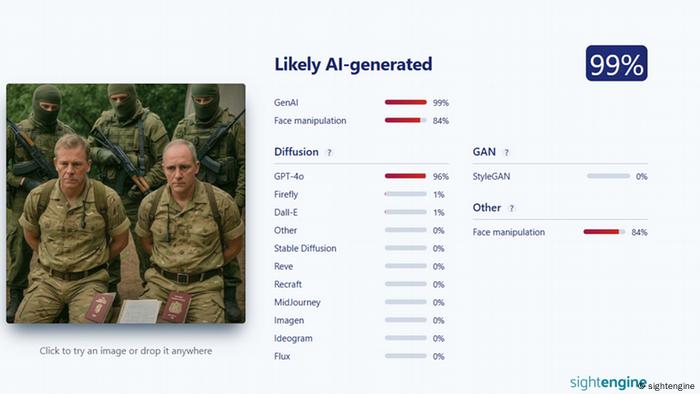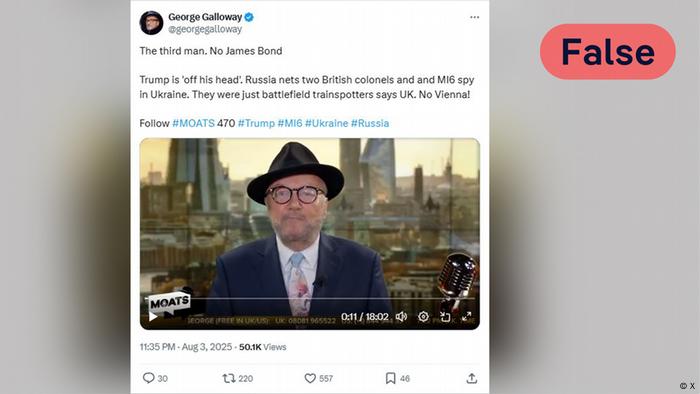Anatomy of a Hoax How AI Fueled a Fake War Story
Despite featuring AI-generated images that look like cheap cartoons, complete with illegible floating passports and characters who don't exist, a completely fabricated story gained massive traction online. The tale of three British military officers being "captured" in a Russian raid on a Ukrainian naval base spread across the globe this past week, amplified by former British politicians and reaching audiences from Norway to Pakistan.
Here, we dissect this narrative, which displays all the classic signs of Russian disinformation, and trace the channels it used to spread.
The Fabricated Claim: A Daring but Fictional Raid
The story, which first surfaced in Russian media, claimed that three British military officers were captured during a raid by elite spetsnaz (special forces) troops in Ochakiv, Ukraine. The social media posts promoting the story garnered hundreds of thousands of views.

The fictional officers were even given names: "psychological ops specialist Edward Blake" and "Richard Carroll – a Ministry of Defence official with Middle East experience." While it would have been a spectacular military and diplomatic event if true, the story is entirely made up.
As the specialist UK Defence Journal (UKDJ) reported, there is no trace of an "Edward Blake" or "Richard Carroll" in any recent British Armed Forces or Ministry of Defence (MoD) records. The UKDJ concluded, "In short, there is no proof these individuals exist, let alone that they were captured." The British MoD declined to even acknowledge the story when asked for comment.
The Telltale Signs of AI Forgery
Beyond the non-existent personnel, the visual "evidence" used to support the story is demonstrably fake. The four different images circulating depict six different men and were clearly generated using artificial intelligence.
The SightEngine AI image detection tool confirmed the high probability of the images being AI-generated, with scores between 91% and 99%. However, the visual errors are obvious to the naked eye: cartoonish faces, oversized limbs, upside-down rifles, nonsensical documents, and an officer's cap missing its peak.

The UKDJ also pointed out glaring inaccuracies in the uniforms. "While the camouflage superficially resembles British Army patterns, the details are wrong... these deviations suggest that the uniforms were generated based on visual approximations rather than real references."
Anatomy of a Russian Disinformation Campaign
The story's creation and spread follow a familiar pattern. According to Roman Osadchuk, an expert at LetsData and the Atlantic Council's Digital Forensic Research Lab, this is a typical Russian disinformation operation.
He explained the process, known as "media laundering":
"The idea is simple: seed it on fringe or fake websites, forward it via Telegram channels until more outlets pick it up and begin to cite each other... Then more mature Telegram channels with more followers will pick it up, and finally mainstream Russian media kick in, and the echo chamber grows. Then, there's a chance that certain foreign actors will pick it up."
This is exactly what happened, with the story appearing in Russian outlets before being reproduced by the Kremlin-controlled EurAsia Daily and Serbia's state-owned B92.
Amplification in the West: How Fake News Finds an Audience
The story soon found influential voices in the West. In the United Kingdom, it was shared by former members of parliament George Galloway, who previously worked for the Russian state-owned RT broadcaster, and Andrew Bridgen, who was expelled from the Conservative Party in 2023 for controversial comments. Their combined following on X (formerly Twitter) exceeds one million users.

The Motive: Who is This Propaganda For?
According to Osadchuk, while the propaganda targets "disgruntled people who believe that 'the mainstream media won't publish this,'" the primary audience is likely inside Russia itself. The goal is "to show Russians how mighty the military is."
This narrative also plays into a key trope of Russian propaganda: that the 'Anglo-Saxons' are the puppeteers conducting the war. "It's the trope of the external enemy," Osadchuk explained. "It's not Ukraine resisting; the British must be behind it."
Combating Disinformation: To Engage or Ignore?
When faced with intentionally false stories like this, what is the best response? Osadchuk advises a measured approach based on the story's reach.
"We can ignore disinformation until certain thresholds," he noted. "If it's just a crazy comment beneath a social media post with five views, then just ignore it. But if a story starts to be disseminated on multiple platforms or if... former members of a country's parliament are sharing it, it starts to become more substantial and should be debunked."


